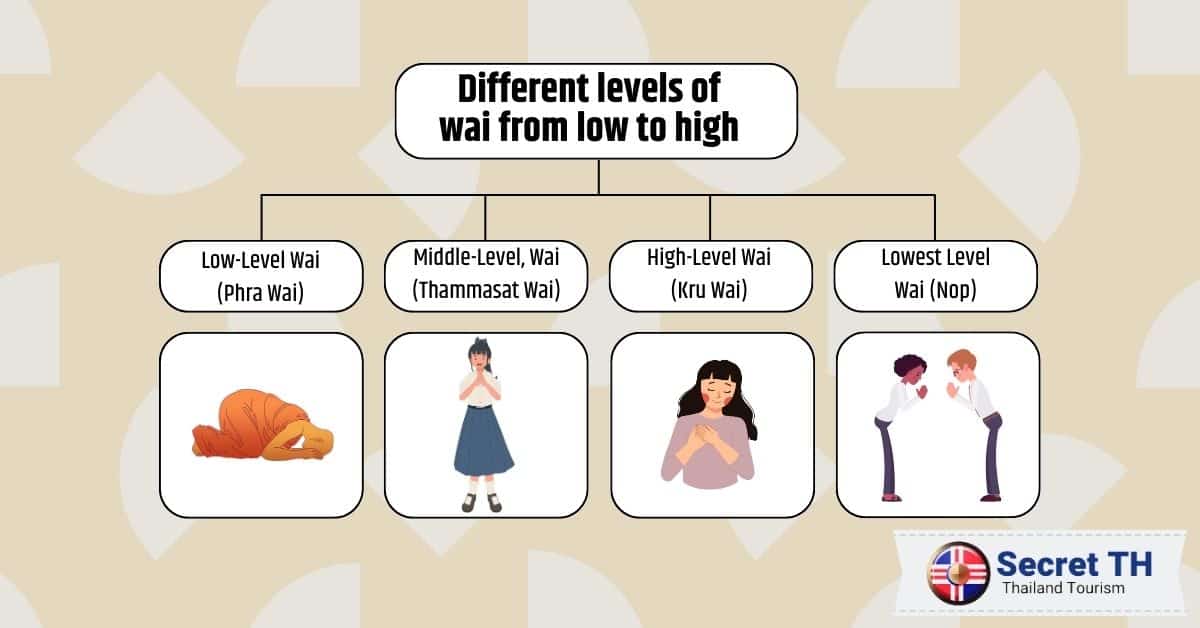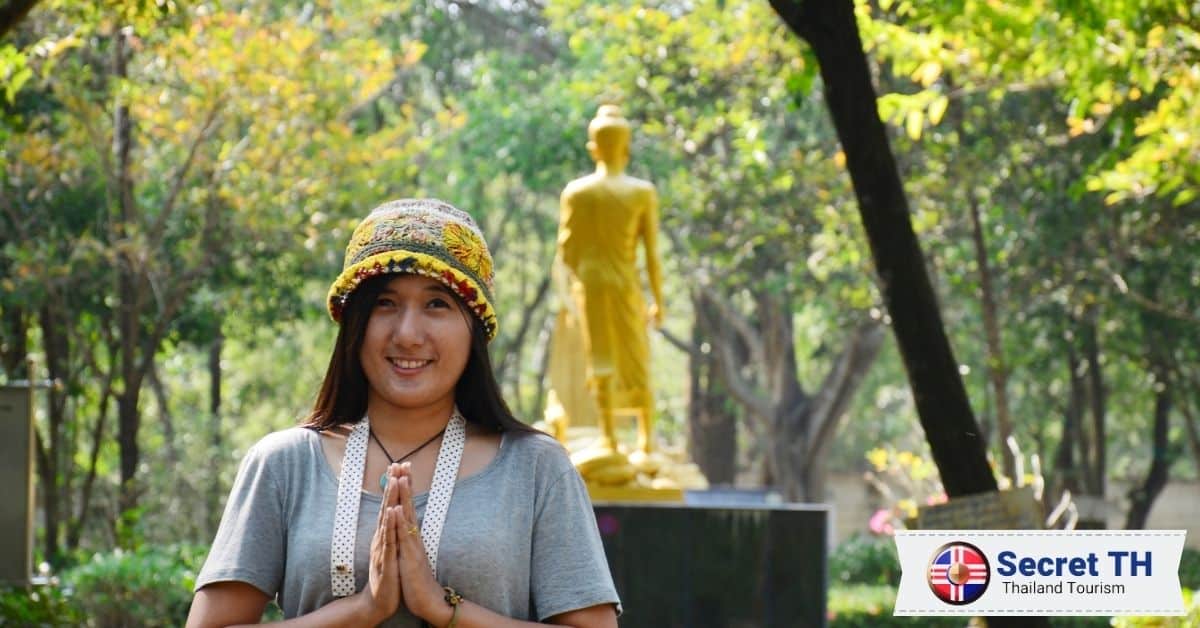The “Wai” is a traditional Thai greeting that involves a slight bow, with the palms pressed together in a prayer-like fashion. It’s an integral part of Thai etiquette, showing respect and friendliness. As a global traveler, embracing local traditions and customs can open doors to rich and rewarding experiences. Understanding and correctly performing the Wai can greatly enhance your cultural immersion and relationship with locals.
If you’re planning a trip to Thailand or already finding yourself amidst the Land of Smiles, mastering the art of the traditional Thai greeting, the “Wai,” should be on your to-do list. Not only does the Wai serve as a greeting, but it’s also a gesture of respect and a window into the warm and welcoming nature of Thai culture. This guide will walk you through the key aspects of the ‘Wai,’ helping you navigate Thai social norms with ease and confidence. Join us as we delve into the beauty and subtlety of this symbolic gesture so you can enrich your journey in Thailand.
Wai Basics: What is a Wai?
The Wai is a traditional form of greeting, commonly practiced in Thailand. Resembling a prayer-like gesture involves bringing the palms together at chest or nose level while giving a slight bow. This symbol of respect and politeness is used in various social settings such as introductions, farewells, or when expressing gratitude. The height of the hands and the depth of the bow can vary, reflecting the relative status of the people involved. Understanding and using the Wai properly is a key element in navigating Thai social customs and etiquette. It’s more than a simple hello; it’s a cultural staple.

How to make a proper Wai greeting for different occasions
When greeting a single person, the hands should be held at chest level and the head bowed slightly. For two people, place both hands together at nose level and bow even deeper. When meeting someone of higher social status or rank. Your palms should be brought together in front of your forehead and you should bow more deeply than usual. To convey extreme respect, bring both palms to the forehead, bow deeply, and keep your eyes lowered.
The Wai is also sometimes used to express gratitude or apologize. It’s important to remember that this gesture should be used sparingly in such contexts. Too much bowing can seem excessive and insincere. In formal situations where other forms of greeting are likely, it’s better to err on the side of caution and use the traditional handshake.

Different levels of wai from low to high
In this section, we delve deeper into the intricacies of the Wai. We explore the various levels from low to high. The degree of respect expressed through this traditional Thai greeting is intricately related to the positioning of the hands. The depth of the bow is akin to a nuanced, silent dialog.

1. Low-Level Wai (Phra Wai): This is typically used when greeting monks or Buddha images. The hands are raised to the forehead with the thumbs touching the forehead. The index fingers create a peak over the nose. The body is usually bowed forward. This is the highest form of the Wai, reflecting the highest respect possible.
2. Middle-Level, Wai (Thammasat Wai): This is used when addressing people of high status or age, like parents, teachers, or bosses. The hands are brought together at the level of the nose, and a bow is made.
3. High-Level Wai (Kru Wai): This Wai is used for greeting peers or people of equal status. The hands are placed together at chest level and a slight bow is made with the head.
4. Lowest Level Wai (Nop): This is the most common form of Wai, performed in routine, informal situations. The hands are held at chest level, and a slight bow is made with the head. It is used among friends, younger people, and in relaxed social settings.
When to Wai?
Understanding when to employ the Wai greeting is just as essential as knowing how to perform it correctly. In this section, we’ll delve into the subtleties of timing for the Wai, offering insight into the situations and contexts where this traditional Thai greeting is most appropriate. We’ll navigate the social cues and cultural nuances that dictate the use of the Wai, ensuring you can confidently and respectfully engage with this rich aspect of Thai culture.
Times when it is appropriate and expected for foreigners to wai
When you are introduced to someone of a higher social status or rank, it’s expected that you will Wai them as a gesture of respect. When entering a temple or other religious spaces, the Wai is also appropriate and expected. The same goes for when paying respects to an image of Buddha or monk. Furthermore, Thais often Wai each other during formal occasions such as weddings or funerals.

Situations where a wai should not be used
In casual settings, like when meeting friends or family, the Wai is not expected. Additionally, it should be avoided on occasions where other forms of greeting are likely to be used, such as business meetings or professional events. It’s also important to note that there may be regional differences in regard to the use of the Wai; for example, some areas may not practice it.

Examples of inappropriate occasions for using the wai greeting
While understanding when to use the Wai is essential, it’s equally important to recognize situations where its usage might be considered inappropriate. Awareness of these instances can help you navigate Thai social customs more fluently and avoid potential faux pas. Here are some examples of situations where the use of Wai may be seen as out of place:

- To Service Workers: Wai is typically not returned to service workers such as waitstaff, street vendors, or taxi drivers. As these are considered informal interactions, a simple thank you or smile suffices.
- To Children or Younger People: It’s uncommon to Wai children or individuals significantly younger than yourself, as it’s generally used to show respect to elders or those of higher status.
- In Busy, Fast-Paced Situations: In situations where people are in a hurry, such as bustling markets or crowded streets, the Wai may be impractical and go unnoticed.
- When Carrying Objects: If your hands are full or you’re carrying something, attempting to Wai can seem awkward and unnecessary.
- When Receiving a Wai from a Younger or Lower Status Individual: If a younger person or someone of lower social status gives you a Wai, it’s polite to acknowledge it with a nod or smile, but it’s not necessary to return the gesture.
Wai Etiquette: What Not to Do
When giving a Wai, it’s important not to make too much eye contact as this is considered rude. It can also be seen as aggressive or intimidating if one person maintains a higher level of eye contact than the other. Avoid raising your head too quickly when ending the greeting as this may appear rushed or abrupt. Also, try not to make any sudden movements or gestures during the Wai – it should be a subtle and graceful exchange of respect.
It’s appropriate to give a Wai when saying goodbye, but don’t forget to reciprocate if you receive one in return. Lastly, be mindful of the cultural context; although the Wai is a universal thing, it can be seen as offensive or inappropriate if used in certain settings.

Conclusion
Mastering the art of the Wai is integral to immersing oneself in Thai culture and traditions. As we’ve seen, the Wai is much more than a simple greeting. It is a symbolic gesture that conveys respect and acknowledges social hierarchy. Also, it communicates a vast array of sentiments ranging from gratitude to apology. While it might seem intricate and nuanced to beginners, understanding the different levels of the Wai.
Recognizing when to use it, and adhering to the associated etiquette transforms this traditional greeting. It is a powerful tool for expressing respect and navigating Thai social customs. As with all intercultural exchanges, practicing mindfulness, sensitivity, and a willingness to learn. This will ensure the Wai is performed with the sincerity and respect it warrants.













